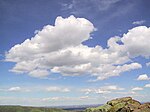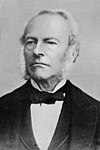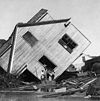Portal:Weather
The weather portal
Weather is the state of the atmosphere, describing for example the degree to which it is hot or cold, wet or dry, calm or stormy, clear or cloudy. On Earth, most weather phenomena occur in the lowest layer of the planet's atmosphere, the troposphere, just below the stratosphere. Weather refers to day-to-day temperature, precipitation, and other atmospheric conditions, whereas climate is the term for the averaging of atmospheric conditions over longer periods of time. When used without qualification, "weather" is generally understood to mean the weather of Earth.
Weather is driven by air pressure, temperature, and moisture differences between one place and another. These differences can occur due to the Sun's angle at any particular spot, which varies with latitude. The strong temperature contrast between polar and tropical air gives rise to the largest scale atmospheric circulations: the Hadley cell, the Ferrel cell, the polar cell, and the jet stream. Weather systems in the middle latitudes, such as extratropical cyclones, are caused by instabilities of the jet streamflow. Because Earth's axis is tilted relative to its orbital plane (called the ecliptic), sunlight is incident at different angles at different times of the year. On Earth's surface, temperatures usually range ±40 °C (−40 °F to 104 °F) annually. Over thousands of years, changes in Earth's orbit can affect the amount and distribution of solar energy received by Earth, thus influencing long-term climate and global climate change.
Surface temperature differences in turn cause pressure differences. Higher altitudes are cooler than lower altitudes, as most atmospheric heating is due to contact with the Earth's surface while radiative losses to space are mostly constant. Weather forecasting is the application of science and technology to predict the state of the atmosphere for a future time and a given location. Earth's weather system is a chaotic system; as a result, small changes to one part of the system can grow to have large effects on the system as a whole. Human attempts to control the weather have occurred throughout history, and there is evidence that human activities such as agriculture and industry have modified weather patterns.
Studying how the weather works on other planets has been helpful in understanding how weather works on Earth. A famous landmark in the Solar System, Jupiter's Great Red Spot, is an anticyclonic storm known to have existed for at least 300 years. However, the weather is not limited to planetary bodies. A star's corona is constantly being lost to space, creating what is essentially a very thin atmosphere throughout the Solar System. The movement of mass ejected from the Sun is known as the solar wind. (Full article...)
Selected article
A jet stream is a fast flowing, relatively narrow air current found at the tropopause, the transition between the troposphere (where temperature decreases with height) and the stratosphere (where temperature increases with height). Jet streams are typically located at 10-15 kilometers above the surface of the Earth. They form near boundaries of adjacent air masses with significant differences in temperature, such as the polar region and the warmer air to the south. The path of the jet typically has a meandering shape, and these meanders known as Rossby waves. Rossby waves propagate westward with respect to the flow in which they are embedded, which translates to a slower eastward migration across the globe than smaller scale short wave troughs. The major jet streams are westerly winds (flowing west to east) in the Northern Hemisphere.
During the summer, low-level easterly jets can form in tropical regions. A southerly low level jet in the Great Plains of North America helps fuel overnight thunderstorm activity, normally in the form of mesoscale convective systems. A similar northerly low-level jet can form across Australia, instigated by cut-off lows which develop across southwest portions of the country.
Meteorologists use the location of the jet stream as an aid in weather forecasting. The main commercial use of the jet stream is during airline travel, as flying long distances along the jet stream can cut hours off a long distance trip. One type of clear-air turbulence is found in the jet stream's vicinity, which can be a hazard to aircraft. One future benefit of the jet stream could be to augment power generation within the next 10 to 20 years, if technological hurdles can be overcome.

Recently selected articles: Weather front, Water cycle, More...
Did you know (auto-generated) -

- ... that after Irish post office clerk Maureen Flavin Sweeney reported worsening weather conditions, Dwight D. Eisenhower agreed to postpone D-Day by 24 hours?
- ... that Japanese actor Kouhei Higuchi prepared for his role on the television drama adaptation of My Personal Weatherman by learning from a weather forecaster?
- ... that the weather forecast for HD 189733 b is "Westerly winds at 2000 m/s, with molten glass showers"?
- ... that extreme event attribution estimates how much climate change causes weather events, such as the 2021 Western North America heat wave?
- ... that Eric Berger wrote about weather for the Houston Chronicle even before he became a certified meteorologist?
- ... that an attempted British-Norwegian attack on the German battleship Tirpitz was abandoned after two Chariot manned torpedoes were lost due to bad weather?
Selected image

The May 22-23, 1981 Tornado Outbreak was a series of destructive tornadoes which injured 12 people and caused $32.8 million (1981 USD) in damage. However, the outbreak is most notable for the spectacularly photogenic Cordell, Oklahoma tornado seen above, which has appeared in many tornado videos and documentaries. Tornadoes are normally oriented vertically, however this tornado was impacted by a gust front from its parent thunderstorm, which stretched it in a horizontal direction. The tornado produced F2 damage, and dissipated shortly after this photo was taken.
Recently selected pictures: Mammatus clouds, Von Kármán vortex street, Crepuscular rays, More...
More did you know...
...that the Flying river is the name given to the transport of water vapor from the Amazon rainforest to southern Brazil?
...that hurricane shutters are required for all homes in Florida unless impact-resistant glass is used?
...that the Joint Institute for Marine and Atmospheric Research is a combined weather and ocean research institute with the cooperation of the Office of Oceanic and Atmospheric Research and the University of Hawaiʻi?
...that the SS Central America was sunk by a hurricane while carrying more than 30,000 pounds (13,600 kg) of gold, contributing to the Panic of 1857?
...that a hurricane force wind warning is issued by the United States National Weather Service for storms that are not tropical cyclones but are expected to produce hurricane-force winds (65 knots (75 mph; 120 km/h) or higher)?
...that the Automated Tropical Cyclone Forecasting System is a software package for tropical cyclone forecasting developed in 1988 that is still used today by meteorologists in various branches of the US Government?
Recent and ongoing weather
- Wikinews weather portal
- March 26, 2021: Tropical moisture ceases to cause severe floods in South East Australia
- February 19, 2021: Winter storms hammer Texas, fatalities reported
- December 28, 2021: Typhoon Phanfone strikes Philippines
- February 1, 2022: Deadly floods in Brazil after heavy rainfall
- April 15, 2022: South African floods kill at least 300 people
- Weather of 2024
- 2024 Atlantic hurricane season
- 2020–21 North American winter
- 2024 Pacific typhoon season
- Tornadoes of 2024
This week in weather history...
June 3
2007: Cyclone Gonu became the most intense tropical cyclone ever recorded in the Arabian Sea, with maximum sustained winds of 270 kilometres per hour (170 mph), eventually causing more than $4 billion (2007 USD) in damage in Oman and Iran.
June 4
2014: Tropical Storm Boris dissipated over the Gulf of Tehuantepec, but not before causing significant damage, flooding, and landslides that killed 6 people in Guatemala and southern Mexico.
June 5
1934: A tropical storm struck the coast of Belize (then known as British Honduras). The storm would meander through Central America for several days, causing flooding which killed as many as 3,000 people.
June 6
1989: Typhoon Dot made landfall on the island of Samar, Philippines, causing widespread flooding and power outages.
June 7
1993: Levees began to be overtopped, marking the start of the Great Flood of 1993, one of the worst floods in US history.
June 8
1924: Samuel B. Avis, a former member of United States House of Representatives, was struck and killed by lightning in Charleston, West Virginia.
June 9
1953: On the final day of a deadly three-day tornado outbreak, a violent tornado plowed through the city of Worcester, Massachusetts and surrounding towns, killing 90 people.
Selected biography
Sir George Gabriel Stokes, 1st Baronet, FRS (/stoʊks/; 13 August 1819 – 1 February 1903) was an Irish physicist and mathematician. Born in County Sligo, Ireland, Stokes spent all of his career at the University of Cambridge, where he was the Lucasian Professor of Mathematics from 1849 until his death in 1903. As a physicist, Stokes made seminal contributions to fluid mechanics, including the Navier–Stokes equations; and to physical optics, with notable works on polarization and fluorescence. As a mathematician, he popularised "Stokes' theorem" in vector calculus and contributed to the theory of asymptotic expansions. Stokes, along with Felix Hoppe-Seyler, first demonstrated the oxygen transport function of haemoglobin, and showed colour changes produced by the aeration of haemoglobin solutions.
Stokes was made a baronet by the British monarch in 1889. In 1893 he received the Royal Society's Copley Medal, then the most prestigious scientific prize in the world, "for his researches and discoveries in physical science". He represented Cambridge University in the British House of Commons from 1887 to 1892, sitting as a Conservative. Stokes also served as president of the Royal Society from 1885 to 1890 and was briefly the Master of Pembroke College, Cambridge. Stokes's extensive correspondence and his work as Secretary of the Royal Society has led him to be referred to as a gatekeeper of Victorian science, with his contributions surpassing his own published papers. (Full article...)
Previously selected biographies: Clement Lindley Wragge, Robert Case, More...
Related portals
Quality content
Other candidates:
- Featured Article Review: 2005 Atlantic hurricane season (Discussion)
- Featured List Removal Candidate: List of storms in the 2005 Atlantic hurricane season (Discussion)
Subcategories
WikiProjects
The scope of WikiProject Weather is to have a single location for all weather-related articles on Wikipedia.
WikiProject Meteorology is a collaborative effort by dozens of Wikipedians to improve the quality of meteorology- and weather-related articles. If you would like to help, visit the project talk page, and see what needs doing.
WikiProject Severe weather is a similar project specific to articles about severe weather. Their talk page is located here.
WikiProject Tropical cyclones is a daughter project of WikiProject meteorology. The dozens of semi-active members and several full-time members focus on improving Wikipedia's coverage of tropical cyclones.
WikiProject Non-tropical storms is a collaborative project to improve articles related to winter storms, wind storms, and extratropical cyclones.
Wikipedia is a fully collaborative effort by volunteers. So if you see something you think you can improve, be bold and get to editing! We appreciate any help you can provide!
Associated Wikimedia
The following Wikimedia Foundation sister projects provide more on this subject:
-
Commons
Free media repository -
Wikibooks
Free textbooks and manuals -
Wikidata
Free knowledge base -
Wikinews
Free-content news -
Wikiquote
Collection of quotations -
Wikisource
Free-content library -
Wikiversity
Free learning tools -
Wiktionary
Dictionary and thesaurus


































